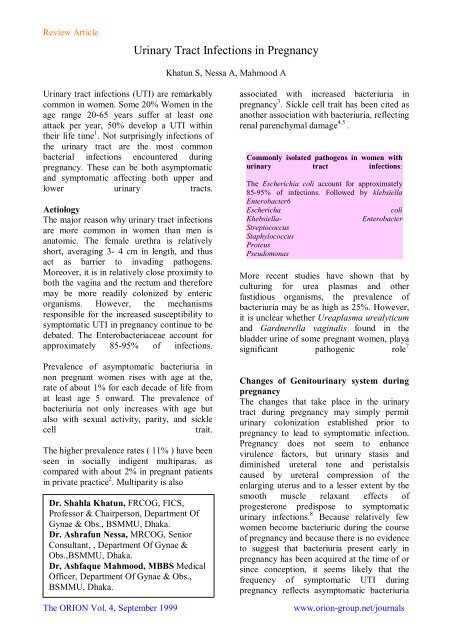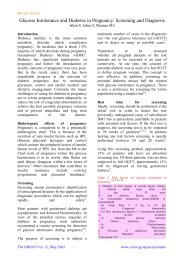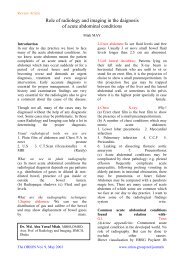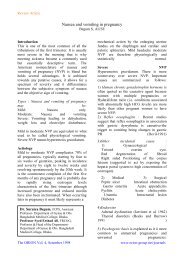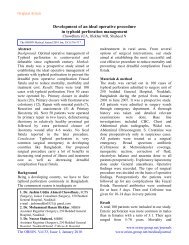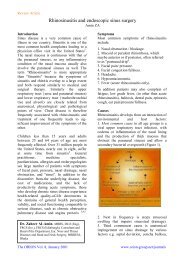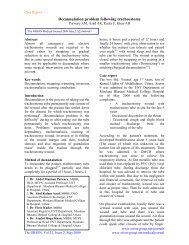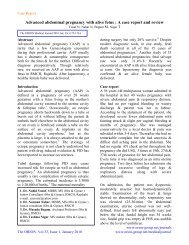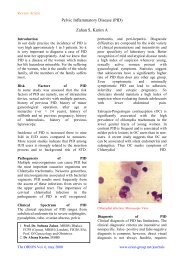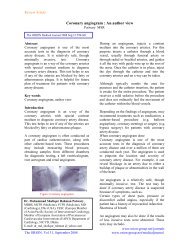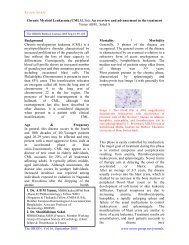Urinary Tract Infections in Pregnancy - ResearchGate
Urinary Tract Infections in Pregnancy - ResearchGate
Urinary Tract Infections in Pregnancy - ResearchGate
You also want an ePaper? Increase the reach of your titles
YUMPU automatically turns print PDFs into web optimized ePapers that Google loves.
Review Article<br />
<strong>Ur<strong>in</strong>ary</strong> <strong>Tract</strong> <strong>Infections</strong> <strong>in</strong> <strong>Pregnancy</strong><br />
Khatun S, Nessa A, Mahmood A<br />
<strong>Ur<strong>in</strong>ary</strong> tract <strong>in</strong>fections (UTI) are remarkably<br />
common <strong>in</strong> women. Some 20% Women <strong>in</strong> the<br />
age range 20-65 years suffer at least one<br />
attack per year, 50% develop a UTI with<strong>in</strong><br />
their life time 1 . Not surpris<strong>in</strong>gly <strong>in</strong>fections of<br />
the ur<strong>in</strong>ary tract are the most common<br />
bacterial <strong>in</strong>fections encountered dur<strong>in</strong>g<br />
pregnancy. These can be both asymptomatic<br />
and symptomatic affect<strong>in</strong>g both upper and<br />
lower ur<strong>in</strong>ary tracts.<br />
Aetiology<br />
The major reason why ur<strong>in</strong>ary tract <strong>in</strong>fections<br />
are more common <strong>in</strong> women than men is<br />
anatomic. The female urethra is relatively<br />
short, averag<strong>in</strong>g 3- 4 cm <strong>in</strong> length, and thus<br />
act as barrier to <strong>in</strong>vad<strong>in</strong>g pathogens.<br />
Moreover, it is <strong>in</strong> relatively close proximity to<br />
both the vag<strong>in</strong>a and the rectum and therefore<br />
may be more readily colonized by enteric<br />
organisms. However, the mechanisms<br />
responsible for the <strong>in</strong>creased susceptibility to<br />
symptomatic UTI <strong>in</strong> pregnancy cont<strong>in</strong>ue to be<br />
debated. The Enterobacteriaceae account for<br />
approximately 85-95% of <strong>in</strong>fections.<br />
Prevalence of asymptomatic bacteriuria <strong>in</strong><br />
non pregnant women rises with age at the,<br />
rate of about 1% for each decade of life from<br />
at least age 5 onward. The prevalence of<br />
bacteriuria not only <strong>in</strong>creases with age but<br />
also with sexual activity, parity, and sickle<br />
cell<br />
trait.<br />
The higher prevalence rates ( 11% ) have been<br />
seen <strong>in</strong> socially <strong>in</strong>digent multiparas, as<br />
compared with about 2% <strong>in</strong> pregnant patients<br />
<strong>in</strong> private practice 2 . Multiparity is also<br />
Dr. Shahla Khatun, FRCOG, FICS,<br />
Professor & Chairperson, Department Of<br />
Gynae & Obs., BSMMU, Dhaka.<br />
Dr. Ashrafun Nessa, MRCOG, Senior<br />
Consultant, , Department Of Gynae &<br />
Obs.,BSMMU, Dhaka.<br />
Dr, Ashfaque Mahmood, MBBS Medical<br />
Officer, Department Of Gynae & Obs.,<br />
BSMMU, Dhaka.<br />
The ORION Vol. 4, September 1999<br />
associated with <strong>in</strong>creased bacteriuria <strong>in</strong><br />
pregnancy 3 . Sickle cell trait has been cited as<br />
another association with bacteriuria, reflect<strong>in</strong>g<br />
renal parenchymal damage 4.5 .<br />
Commonly isolated pathogens <strong>in</strong> women with<br />
ur<strong>in</strong>ary tract <strong>in</strong>fections:<br />
The Escherichia coli account for approximately<br />
85-95% of <strong>in</strong>fections. Followed by klebsiella<br />
Enterobacter6<br />
Eschericha<br />
coli<br />
Khebsiella-<br />
Enterobacter<br />
Streptococcus<br />
Staphylococcus<br />
Proteus<br />
Pseudomonas<br />
More recent studies have shown that by<br />
cultur<strong>in</strong>g for urea plasmas and other<br />
fastidious organisms, the prevalence of<br />
bacteriuria may be as high as 25%. However,<br />
it is unclear whether Ureaplasma urealyticum<br />
and Gardnerella vag<strong>in</strong>alis found <strong>in</strong> the<br />
bladder ur<strong>in</strong>e of some pregnant women, playa<br />
significant pathogenic role 7<br />
Changes of Genitour<strong>in</strong>ary system dur<strong>in</strong>g<br />
pregnancy<br />
The changes that take place <strong>in</strong> the ur<strong>in</strong>ary<br />
tract dur<strong>in</strong>g pregnancy may simply permit<br />
ur<strong>in</strong>ary colonization established prior to<br />
pregnancy to lead to symptomatic <strong>in</strong>fection.<br />
<strong>Pregnancy</strong> does not seem to enhance<br />
virulence factors, but ur<strong>in</strong>ary stasis and<br />
dim<strong>in</strong>ished ureteral tone and peristalsis<br />
caused by ureteral compression of the<br />
enlarg<strong>in</strong>g uterus and to a lesser extent by the<br />
smooth muscle relaxant effects of<br />
progesterone predispose to symptomatic<br />
ur<strong>in</strong>ary <strong>in</strong>fections. 8 Because relatively few<br />
women become bacteriuric dur<strong>in</strong>g the course<br />
of pregnancy and because there is no evidence<br />
to suggest that bacteriuria present early <strong>in</strong><br />
pregnancy has been acquired at the time of or<br />
s<strong>in</strong>ce conception, it seems likely that the<br />
frequency of symptomatic UTI dur<strong>in</strong>g<br />
pregnancy reflects asymptomatic bacteriuria<br />
www.orion-group.net/journals
Review Article<br />
acquired periodically by certa<strong>in</strong> woman very<br />
early <strong>in</strong> life or later. 9<br />
Though some authors (Patterson TF et al.)<br />
believe that profound physiologic changes<br />
affect<strong>in</strong>g the entire ur<strong>in</strong>ary tract occur dur<strong>in</strong>g<br />
pregnancy may have a significant impact on<br />
the natural history of UTI dur<strong>in</strong>g gestation. 10<br />
Dilatation of the upper collect<strong>in</strong>g system<br />
occurs <strong>in</strong> most .normal pregnancies and<br />
extends down to the level of the pelvic brim.<br />
These changes are more pronounced on the<br />
right than the left, largely ow<strong>in</strong>g to the sharp<br />
angle of the right ureter follows on its drop<br />
<strong>in</strong>to the pelvic cavity. Ureteral peristalsis is<br />
reduced after the second month of gestation,<br />
with long periods of complete agony seen <strong>in</strong><br />
the seventh and eighth months of pregnancy,<br />
likely a result of hormonal change. 11 Dilated<br />
ureters can hold up to 200 mi of ur<strong>in</strong>e. 12<br />
The bladder, like the ureters, undergoes a<br />
progressive decrease <strong>in</strong> tone and a subsequent<br />
<strong>in</strong>crease <strong>in</strong> capacity . Later <strong>in</strong> pregnancy, the<br />
bladder may conta<strong>in</strong> double its normal<br />
volume without discomfort.<br />
Some other studies have suggested that<br />
hormonal rather than mechanical changes<br />
seen dur<strong>in</strong>g pregnancy may be the primary<br />
factors <strong>in</strong>volved <strong>in</strong> the aetiology of<br />
hydroureter. 13<br />
These changes vary from patient to patient<br />
and are more likely to occur dur<strong>in</strong>g first<br />
pregnancies or <strong>in</strong> women who have had their<br />
pregnancies <strong>in</strong> rapid succession. The ur<strong>in</strong>ary<br />
tract tends to revert to normal by the second<br />
month of the puerperium.<br />
Asymptomatic <strong>in</strong>fections (asymptomatic<br />
bacteriuria) :<br />
The reported prevalence of asymptomatic<br />
bacteriuria dur<strong>in</strong>g pregnancy varies from 2%<br />
to 12% depend<strong>in</strong>g on parity, race, and socioeconomic<br />
status. The highest <strong>in</strong>cidence has<br />
been reported <strong>in</strong> black multiparas with sickle<br />
cell trait and the lowest <strong>in</strong>cidence <strong>in</strong> affluent<br />
white women of low parity. Asymptomatic<br />
bacteruria is twice as common <strong>in</strong> pregnant<br />
women with sickle cell trait and 3 times as<br />
The ORION Vol. 4, September 1999<br />
common <strong>in</strong> pregnant woman with diabetes as<br />
<strong>in</strong> normal women.<br />
A woman is considered to be suffer<strong>in</strong>g from<br />
asymptomatic bacteriuria when there is<br />
presence of significant bacteria (by def<strong>in</strong>ition,<br />
≥10 5 of a s<strong>in</strong>gle uropathogen per mL of ur<strong>in</strong>e<br />
collected via clean-voided midstream<br />
sampl<strong>in</strong>g) without associated symptoms such<br />
as dysuria, frequency or suprapubic<br />
discomfort. Counts of less than 10 5 / mL or<br />
specimens yield<strong>in</strong>g two or more organisms<br />
probably represent contam<strong>in</strong>ation and not<br />
<strong>in</strong>fection. 14 To avoid confusion of<br />
contam<strong>in</strong>ation it is better to carry out the test<br />
<strong>in</strong> two consecutive specimens.<br />
Though it is not caus<strong>in</strong>g any apparent<br />
problem to the mother but up to 25-30% of<br />
women will develop acute pyelonephritis and<br />
accord<strong>in</strong>g to some stuwes this may be as high<br />
as 50% if rema<strong>in</strong> untreated and even treated<br />
the affected population will be near 10%.<br />
Keep<strong>in</strong>g the delayed complications <strong>in</strong> m<strong>in</strong>d, it<br />
is wise to treat these cases with antibiotics<br />
whenever they are detected. Different<br />
antibiotics with different durations have been<br />
tried so far. The duration of therapy for<br />
bacteriuria of pregnancy has received much<br />
attention. Early studies used cont<strong>in</strong>uous<br />
therapy until term because of the concern<br />
about treatment failures follow<strong>in</strong>g short<br />
course<br />
therapy.<br />
More recent studies have evaluated s<strong>in</strong>gledoes<br />
therapy for bacteria <strong>in</strong> pregnant women.<br />
It has been suggested that pregnant women,<br />
like non pregnant women with renal <strong>in</strong>fection,<br />
were more difficult to treat and had higher<br />
failure rates with s<strong>in</strong>gle-does therapy. S<strong>in</strong>ce<br />
then more trials have shown that s<strong>in</strong>gle-dose<br />
therapy effectively eradicates bacteriuria <strong>in</strong><br />
pregnancy. But the important issue is not the<br />
length of therapy chosen but that appropriate<br />
follow-up is obta<strong>in</strong>ed to document the<br />
elim<strong>in</strong>ation of bacteriuria.<br />
The ma<strong>in</strong> problem of treat<strong>in</strong>g these cases is<br />
that while select<strong>in</strong>g the drug we have to take<br />
both the mother and the fetus <strong>in</strong> consideration.<br />
The effect of Ampicill<strong>in</strong>, Amoxicill<strong>in</strong>,<br />
www.orion-group.net/journals
Review Article<br />
Cephalospor<strong>in</strong>, have so far been widely<br />
studied and all of them gave good results 15<br />
Ronald et al. used nitrofuranto<strong>in</strong>, also got as<br />
good result as others. 16 But the use of this<br />
drug should be restricted to early pregnancy<br />
as it may <strong>in</strong>duce haemolytic anemia. Peddler<br />
et al. <strong>in</strong> 1985 showed use of augment<strong>in</strong>g gave<br />
significantly good resulU 17 In 1983 Campbell<br />
et al. found that s<strong>in</strong>gle does therapy has lower<br />
<strong>in</strong>itial cure rate.<br />
An affective drug for UTI is trimethoprimsulfamethxazole.<br />
It is necessary to avoid sulfa<br />
drugs dur<strong>in</strong>g pregnancy due to <strong>in</strong>creased<br />
occurrence of neonatal hyperbilirub<strong>in</strong>aemia.<br />
Symptomatic<br />
UTI:<br />
Symptomatic <strong>in</strong>fection of the lower ur<strong>in</strong>ary<br />
tract (acute cystitis) is usually manifested by<br />
dysuria, frequency, urgency along with<br />
positive ur<strong>in</strong>e culture. In the absence of upper<br />
tract <strong>in</strong>volvement patients do not have<br />
systemic symptoms like fever, nausea,<br />
vomit<strong>in</strong>g. Acute pyelonephritis is usually<br />
associated with lo<strong>in</strong> pa<strong>in</strong>. Presence of only<br />
<strong>in</strong>creased frequency of micturition or nocturia<br />
is usually not the symptom of UTI dur<strong>in</strong>g<br />
pregnancy as it can be a normal physiological<br />
adaptation of pregnancy.<br />
Ur<strong>in</strong>e analysis of these patients reveal pus<br />
cells, white cell casts, bacteriuria. Presence of<br />
haematuria <strong>in</strong>dicates ur<strong>in</strong>ary calculi. The<br />
diagnosis needs to be confirmed by ur<strong>in</strong>e<br />
culture.<br />
Beside the usual complications of<br />
pyelonephritis like septicaemia, endotoxic<br />
shock, acute renal failure, pulmonary<br />
dysfunction-the other important concern for<br />
obstetricians is the effect of UTI on the foetus<br />
which <strong>in</strong>cludes IUGR and pre-maturity.<br />
Any pregnant mother who are suspected acute<br />
pyelonephritis should be handled <strong>in</strong>tensively<br />
and hospital admission is <strong>in</strong>dicated. Antibiotic<br />
therapy needs to be started from very beg<strong>in</strong><br />
even before gett<strong>in</strong>g the ur<strong>in</strong>e culture and<br />
sensitivity report. This cases should be treated<br />
with <strong>in</strong>travenous antibiotics <strong>in</strong>itially and after<br />
the systemic manifestation (fever; vomit<strong>in</strong>g)<br />
The ORION Vol. 4, September 1999<br />
improves, oral regimen can be started.<br />
Penicill<strong>in</strong> and cephalospor<strong>in</strong> is the drug of<br />
choice but <strong>in</strong>case of penicill<strong>in</strong> resistant cases<br />
(no improvement with<strong>in</strong> 48- 72 hours)<br />
arn<strong>in</strong>oglycoside like gentamic<strong>in</strong> can be<br />
helpful.<br />
28% of women with pyelonephritis can<br />
develop recurrent bacteriuria and 10%<br />
recurrent acute pyelonephritis dur<strong>in</strong>g the same<br />
pregnancy. 18 In these cases long term<br />
prophylactic treatment with Nitrofuranto<strong>in</strong>,<br />
100 mg every night is advocated by some<br />
authors although the efficacy of such therapy<br />
is questionable.<br />
Conclusion<br />
In all patients with bacteriuria of pregnancy<br />
should be treated and followed up cultures are<br />
taken to document response. Therapy should<br />
be as brief and non-toxic as possible to both<br />
mothers and fetuses. All cases of persistent<br />
asymptomatic bacteriuria throughout<br />
pregnancy or even a s<strong>in</strong>gle attack of acute<br />
pyelonephritis need through post partum<br />
<strong>in</strong>vestigations.<br />
References :<br />
1. Gilstrap LC etal : Renal <strong>in</strong>fection and<br />
pregnancy outcome. Am J Obstet Gynecol<br />
1981; 141 : 709<br />
2. Turck M, Goffe BS, Petersdorf RG:<br />
Bacteriuria of pregnancy: Relation to<br />
Socioeconomic factors, N Engl J Med 1966;<br />
266:857.<br />
3. Savage WE, Hajj SN, Kass EH:<br />
Demographic and prognostic characteristics<br />
of bacteriuria <strong>in</strong> pregnancy. Medic<strong>in</strong>e<br />
1967;46:385.<br />
4. Pritchard JA. Scott DE. Whalley Pj, et al :<br />
The effects of maternal sickle cell<br />
hemoglib<strong>in</strong>opathies and sickle cell trait on<br />
reproductive performance. Amj Obstet<br />
GynecoI1973;117: 662<br />
5. Whallev Pj, Mart<strong>in</strong> FG, pritchard JA:<br />
Sickle cell trait and ur<strong>in</strong>ary tract <strong>in</strong>fection<br />
dur<strong>in</strong>g pregnancy, JAMA 1964; 189: 903.<br />
6. MacDonald P, Alexander D, Catz C et al.<br />
Summary of a workshop on maternal<br />
genitour<strong>in</strong>ary <strong>in</strong>nfection and the outcome of<br />
pregnancy J <strong>in</strong>fect 1983; 147: 596<br />
7. Gilbert GL, Garland SM, Fairley KF, et at:<br />
www.orion-group.net/journals
Review Article<br />
Bacteriuria due to ureaplasmas and other<br />
fastidious organisms dur<strong>in</strong>g pregnancy:<br />
Prevalence and significance. Pediatric Infect<br />
Dis 1986, 5:S139<br />
8. Beydoun SN: Morphologic changes <strong>in</strong><br />
renal tract <strong>in</strong> pregnancy. Cli obstet<br />
Gynecol1985; 28: 249.<br />
9. Savage WE. Hajj SN, Kass EH:<br />
Demographic and prognostic characteristics<br />
of bacteriuria <strong>in</strong> pregnancy. Medic<strong>in</strong>e 1967,46:<br />
46385.<br />
10. Patterson TF, Andriole VT: Bacteriuria <strong>in</strong><br />
pregnancy. Infect Dis Cl<strong>in</strong> North Am 1987; 1:<br />
807.<br />
11. Traut HP, McLane CM: Physiological<br />
changes <strong>in</strong> the ureter associated with<br />
pregnancy. Surg Gynecol obstet 1986; 62:65.<br />
12. L<strong>in</strong>dheimer MD, Katz Al: The kidney <strong>in</strong><br />
pregnancy. N Engl J Med 1970; 283:1095.<br />
13. Fa<strong>in</strong>stat T: Urethral dilatation <strong>in</strong><br />
pregnancy: A review. Obstet Gyneeol Survey<br />
1963; 18:845<br />
14. Norden CW, Kass EH: Bacteriuria of<br />
pregnancy: A critical appraisal , Ann Rew<br />
Med 1968; 19:43.<br />
15. Harris RE, Gilstrap LC. Pretty A: S<strong>in</strong>gledose<br />
antimicrobial therapy for assympwmatic<br />
bacteriuria dur<strong>in</strong>g pregnancy. Obstet<br />
Gynecol1982;59: 546.<br />
16. Ronald AR: Advances <strong>in</strong> the treatment<br />
and prevention of ur<strong>in</strong>ary tract <strong>in</strong>fection.<br />
Mediguide Infect Dis 1985; 5:1.<br />
17. Pedler Sj, B<strong>in</strong>t AJ : Comparative study of<br />
amoxicill<strong>in</strong>- clavulanic and cephalex<strong>in</strong> <strong>in</strong> the<br />
treatment of bacteriuria dur<strong>in</strong>g pregnancy.<br />
Antimiocrob Agents- Chemother 1985;27:<br />
508.<br />
18. Dunn PM: The possible relationship<br />
between the maternal adm<strong>in</strong>istrations of<br />
sulphame thoxpyridaz<strong>in</strong>c and<br />
hyperbilirub<strong>in</strong>emia <strong>in</strong> the newborn.] Obstet<br />
Gynaecol Cornmwealth 1964,71: 128<br />
The ORION Vol. 4, September 1999<br />
www.orion-group.net/journals


